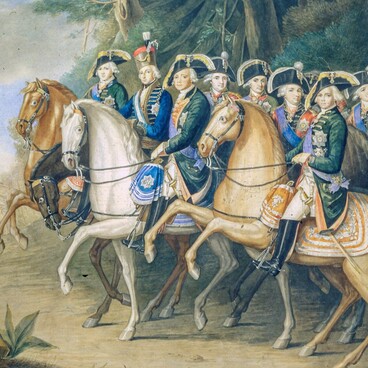In 1940, on the shores of the Arctic Ocean, at the northeastern tip of the Taymyr Peninsula, a group of Soviet sailors of the hydrographic ship “Nord” discovered remains of the winter quarters from an early 17th–century Russian commercial and industrial expedition, which was shipwrecked.
In 1945, the Arctic Institute began excavations on the Faddey Island and in the Simsa Bay. There, archaeologists found wreckage of the ship, a part of a sail, navigation devices, hunting equipment, household items, jewelry, fragments of silk and cloth garments, remains of furbearer species, as well as many Russian coins of the 16th–17th centuries. The findings allowed to expand our understanding of the geography of the Russian 17th–century Arctic exploration: at that time, it was mainly aimed at the east, towards the Pacific Ocean.
On Faddey Island separate fragments of clothing made of homespun cloth were found. By analyzing the preserved fragments, scientists were able to establish how the workwear of a Russian person looked like in the Middle Ages. Experts from the restoration workshops of the Historical Museum under the leadership of Lydia Yakunina managed to recreate the “sailor’s caftan” based on the template of the 17th–century men’s shirt.
The Russians began to explore the Trans-Urals territory long before the campaign of the legendary Cossack ataman Yermak. The first Russians to come there were the Novgorodians and the Pomors — residents of the Russian North. One of the main routes that Russian artisans and traders took to obtain the main Siberian treasures — fur — passed along the coast of the northern seas. Polar navigators, exploring the Northern Sea Route, managed to reach territories which at that time were inaccessible even to the indigenous inhabitants of Siberia.
In 1945, the Arctic Institute began excavations on the Faddey Island and in the Simsa Bay. There, archaeologists found wreckage of the ship, a part of a sail, navigation devices, hunting equipment, household items, jewelry, fragments of silk and cloth garments, remains of furbearer species, as well as many Russian coins of the 16th–17th centuries. The findings allowed to expand our understanding of the geography of the Russian 17th–century Arctic exploration: at that time, it was mainly aimed at the east, towards the Pacific Ocean.
On Faddey Island separate fragments of clothing made of homespun cloth were found. By analyzing the preserved fragments, scientists were able to establish how the workwear of a Russian person looked like in the Middle Ages. Experts from the restoration workshops of the Historical Museum under the leadership of Lydia Yakunina managed to recreate the “sailor’s caftan” based on the template of the 17th–century men’s shirt.
The Russians began to explore the Trans-Urals territory long before the campaign of the legendary Cossack ataman Yermak. The first Russians to come there were the Novgorodians and the Pomors — residents of the Russian North. One of the main routes that Russian artisans and traders took to obtain the main Siberian treasures — fur — passed along the coast of the northern seas. Polar navigators, exploring the Northern Sea Route, managed to reach territories which at that time were inaccessible even to the indigenous inhabitants of Siberia.



